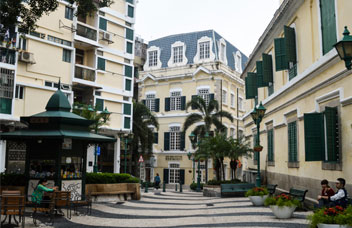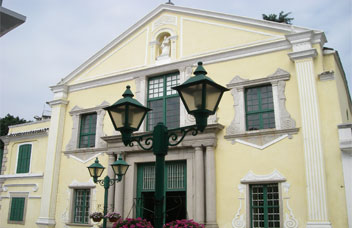- Tour Packages
- Discover Macau
- Tourist Attractions
- Heritage Sites
- A-Ma Temple
- Macau Wine Museum
- Grand Prix Museum
- Moorish Barracks
- Lilau Square
- Mandarin's House
- St. Augustine's Square
- Dom Pedro V Theatre
- Sir Robert Ho Tung Library
- Leal Senado' Building
- Senado Square
- Sam Kai Vui Kun (Kuan Tai Temple)
- Lou Kau Mansion
- Na Tcha Temple
- Section of the Old City Walls
- Mount Fortress
- Casa Garden
- Churches in Macau
- Ruins of St. Paul's
- Hotels
St. Augustine's Square

St. Augustine's Square (Largo de Santo Agostinho) is a beautiful Portuguese-style cobblestone-paved piazza, surrounded by some historical monuments that are well worth knowing about, such as St. Augustine’s Church, Dom Pedro V Theatre, St. Joseph’s Seminary and Sir Robert Ho Tung Library. The cobblestone pavement unifies the area and reflects a traditionally Portuguese streetscape.
St. Augustine's Church, after which the square is called, was first erected in the 1580s by Spanish Augustinian priests but was later taken over by the Portuguese authorities. Well distinguished for its impressive front columns and window decorations, the present neo-classical façade was constructed in 1814 and replaced the Baroque style structure that was there beforehand.
Similar to many old Catholic churches in Macau, the interior is lavishly ornamented with religious pieces of art... One of them in particular has an interesting story behind it: On the marble-clad high altar you will see a statue, depicting Christ carrying the cross... The legend goes that many years ago, when it was once taken to the cathedral by the church people, it somehow found its way back to church's altar.
The festive parade of Nosso Senhor dos Passos (Procession of Our Lord of the Passion) is held yearly to commemorate the miraculous event... The statue is taken to the Cathedral for the night and carried back to the church's altar on the following day.

Still on Largo de Santo Agostinho, next to the entrance of St Joseph's Seminary (across the street from the church) is Sir Robert Ho Tung Library, a late 19th century building that was originally constructed as the mansion of Dona Carolina Cunha. The mansion was purchased in 1918 by Hong Kong businessman Sir Robert Ho Tung, as a retreat, but he also lived there between 1941 to 1945, when Hong Kong was under Japanese occupation.
After he passed away, in 1955, the building was presented to the Government for the conversion to a public library according to his will.
The three-storey library building features a typical example of a beautiful colonial mansion, with an arcade and a garden.
